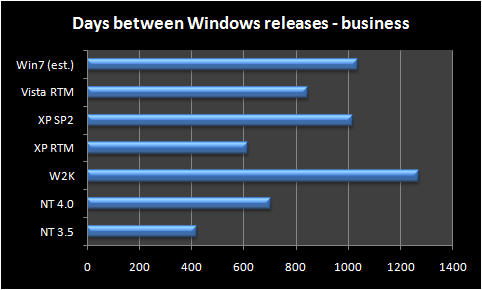Windows 7 = Vista Release 2

All the kerfuffle over Windows 7 - leaked memos, shaky handheld video clips of leaked builds, equally shaky tentative release schedules - is amusing. I don't have any inside information to offer, only a perspective drawn from 17 years of watching the Windows development process in action.
The most common comment I've read lately is that Microsoft has accelerated the development schedule of Windows 7 in a desperate attempt to replace Windows Vista. Dave Methvin at Information Week argues that Windows 7 may mean Vista's "early demise." APC Mag speculates on the meaning of this "early release," complete with a screenshot it calls "probably fake." Randall Kennedy at InfoWorld piles onto the meme with this prediction:
Will Microsoft ship Windows 7 early in an effort to salvage its enterprise reputation? I'm guessing yes, if for no other reason than they can. It won't take a major engineering effort to turn the ashes of Vista (which, despite its reputation, did incorporate some good ideas) into a solid OS that corporate IT actually wants.
All of those predictions miss one big point: There's nothing "early" about the rumored H2 2009 release date of Windows 7. Last June, I argued that Windows Vista was the functional equivalent of Windows 95, with plenty of wrenching architectural changes that spelled pain for early adopters. Most of those problems were fixed with Windows 98. Likewise, despite the current love fest for XP, most people forget that its first years were plagued with bugs, driver hassles, and security problems (remember Blaster?) that weren't stamped out until XP Service Pack 2.
Windows 7 is following perfectly in the footsteps of those two releases. I went and charted the history of Microsoft's Windows releases from 1990 (Windows 3.0) forward, inserting Windows 7 into the mix with a September 30, 2009 release date, which is exactly midway into the second half of 2009. Each bar on the chart represents the number of days after the final release of the previous edition.
Let's start with the history of Windows from the business side:

The biggest bar, of course, is Windows 2000, which went through the longest development cycle of any Microsoft operating system release ever. Windows XP was able to piggyback on that work with a release less than two years later. Getting SP2 out the door with major changes to the security subsystems took roughly 1000 days, and many people at Microsoft, including Steve Ballmer, wanted to give it the full release treatment, a decision that Windows boss Jim Allchin nixed. (See Mary Jo Foley's October 2006 interview with Allchin for more details on this decision.)
Microsoft has a more complicated history when it comes to consumer versions of Windows, as this chart makes clear:
After Windows 98, Microsoft tried to cash in with two quick releases, Windows 98 Second Edition in 1999, and the ill-fated Windows Me in 2000. The business and consumer tracks were synched up for good with the release of Windows XP in October 2001.
What I found most fascinating about looking at this history is that the most stable and successful releases of Windows arrived roughly 1000 days after their trouble-plagued predecessors. Windows 98 arrived 1036 days after the original release of Windows 95. XP Service Pack 2 was released 1016 days after the launch of XP Home and Professional. And if those rumors are true, Windows 7 should arrive roughly 1000 days after Vista's launch.
I certainly don't expect any big changes in Windows 7. In fact, I'm willing to bet that one of its key design goals is that any driver or app written for Windows Vista must work perfectly on Windows 7. All of the compatibility and reliability fixes that have already gone into Windows Vista will be part of Windows 7 from day 1, making it much less likely that users will experience the sorts of headaches that early adopters experienced in the first six months after Vista's release.
I expect to see Internet Explorer 8, a bunch of new digital media features, and some tweaking of User Account Control to make it less obtrusive. Mary Jo is right to call this "a smaller, more finite release," not a big bang like Vista. Those who are predicting that Windows 7 will include some radically stripped-down kernel (the so-called MinWin project) or a new file system are missing the point completely.